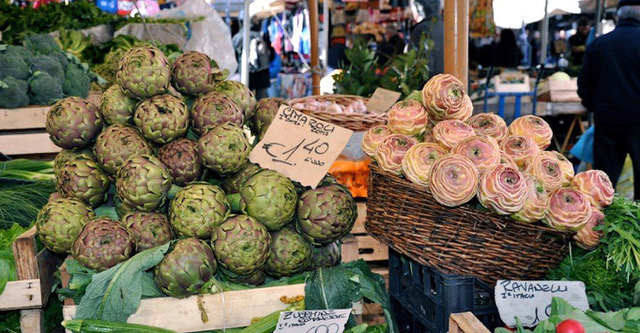The artichoke, il carciofo, has been the cornerstone vegetable of Rome since ancient times. Today more are cultivated in Italy (367,000 tons) than anywhere else in the world and more artichokes are eaten in Rome than any other city.
According to a recipe in De Re Coquinaria by Apicius, they were pickled in honey and vinegar, and seasoned with cumin. On the other hand, his contemporary Pliny the Elder, who died during the 79 AD eruption of Vesuvius, tells us that the artichoke had several beneficial medical effects: as a cure for baldness and indigestion, as a breath freshener, an aphrodisiac, and a guarantee to give birth to boys.
Today in Rome the carciofo is served mainly in two ways. One is alla romana, sculpted into a handbell shape and steamed, often with sliced potatoes, in a covered pot in olive oil with garlic, parsley and mint. It’s ubiquitously found on most Roman restaurant menus when in season between Christmas and Easter.

The other recipe is alla giudìa or “Jewish style”, which dates to 1555 when Pope Paul IV established the ghetto and the Jews, many of whom had no kitchens in their tiny homes, began frying vegetables in boiling hot olive oil in makeshift outdoor stoves. In short, carciofi alla giudìa were Rome’s first street food, which non-Jews avoided eating calling them “the Jewish vegetable”.
In 1570 Bartolomeo Scappi (1500-1577), private chef to Pope Pius V (r. 1566-72), published in Rome the first “modern” recipe for artichokes in his six-volume illustrated “Opera of the Culinary Arts”. He suggested stuffing them with a mixture of veal, ham, cheese, eggs, spices, garlic and herbs.
An amusing artichoke anecdote concerns Angelo Valiani, a farmer from southern Tuscany, who at the end of the 19th century made a name for himself in Rome as “the master of the cold buffet” for his specialty carciofini sott’olio or peeled artichokes preserved in a jar of olive oil. His invention made him a wealthy man so, out of thanks, when his son was born, he wanted to name him “Carciofino”. When the priest refused to baptize the baby with a non-Christian name, Valiani protested: “Father, if our pope Leo XIII has the same name as a wild beast, I see no reason not to name my son after a harmless plant”, so the priest agreed.

Artichokes still continue to plant controversies. During Passover 2018, Israel’s Chief Rabbinate declared that artichokes prepared whole could not be considered kascèr since small bugs might hide among their leaves. The ghetto’s restaurateurs and Rome’s Jewish home cooks were deeply insulted since they’d been preparing carciofi alla giudìa for over 500 years with no problems. To end the controversy Rome’s Chief Rabbi Riccardo Di Segni made a video of himself preparing this Roman delicacy while wishing holiday greetings to his community.
To enjoy Rome’s Kascèr carciofi alla giudîa in the former ghetto, head to Bellacarne Kosher Grill, Renato al Ghetto, Ba’ Ghetto, and Nonna Betta, all good, although my favorites are La Taverna del Ghetto and around the corner on Piazza Cenci Yotvata.

Nearby are another three even better-known “Jewish” but not Kascèr restaurants: Evangelista, Dal Pompiere, and Piperno, already famous with foreign tourists when the ghetto was still locked at night. It wasn’t until 1870, when Italy was unified, that the ghetto was demolished and King Vittorio Emanuele II gave the Jews full Italian citizenship and the right to live wherever they pleased.
Back home again, the best souvenir of Rome’s ghetto and its carciofi is Brooklynite Leah Koenig’s newest (2023) book Portico: Cooking and Feasting in Rome’s Jewish Kitchen illustrating the ghetto’s history and food with magnificent photographs and 100 recipes. $37.50.












